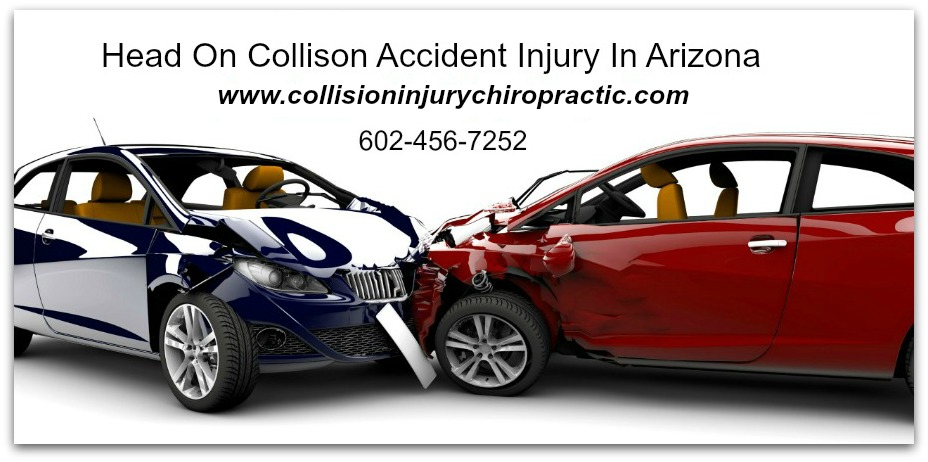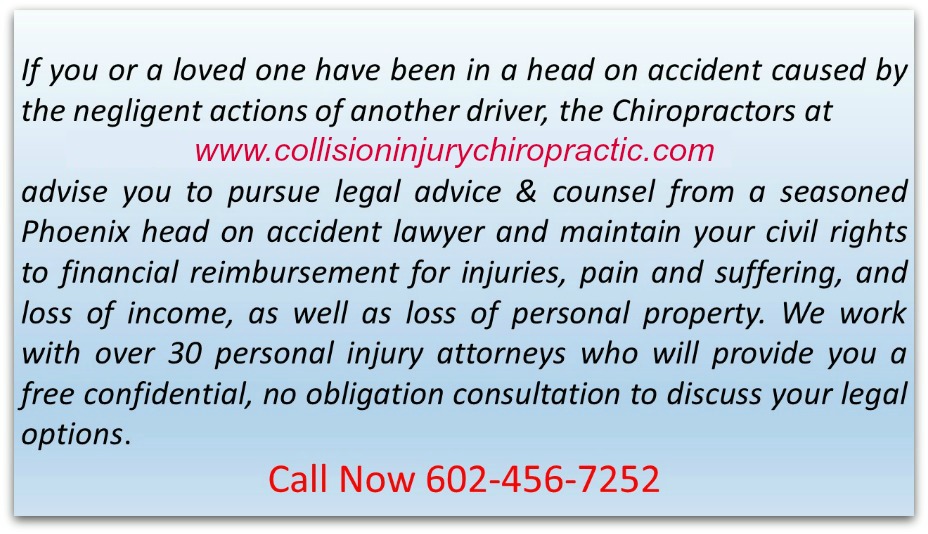Head-on Collision

Head-On Collision Injury Auto Accident Treatments
Head-On Collision or Frontal crash defined
Head-on collisions, known as frontal crashes, take place when the front end of one vehicle hits a stationary object, or even worse, the front of an oncoming vehicle. Head-on, or frontal crashes, are in a category all by themselves as the most deadly of all collisions. This is because they typically cause serious injuries and can even be the cause of vehicular fatality.
Call us today for a free no obligation consultation.
602-456-7252.
Head-on, or frontal collision, impact takes place as one vehicle crosses the center line and ends up driving in the wrong or opposite lane where there is oncoming traffic. This can also occur when a driver enters a one way street and is going in opposition of traffic.
Damage to your car and the oncoming car can vary greatly when there is a head-on collision with the front ends of the vehicles lined up directly with one another. Even worse is when a frontal collision occurs with each vehicle colliding in an offsetting manner. Think of the left 1/3 of car A hitting the left 1/3 of the oncoming car B. This same idea also applies to hitting a stationary object.
The Good, The Bad, and The Real Results Of Automobile Technology
Although head-on collisions account for only 2% of the total vehicle collisions in the US, they are responsible for ten percent (10%) of vehicular crash deaths. Obviously, this points out how devastating head on collisions can be.
Seatbelts, mandatory in Arizona since January 1, 1991, and air bags, mandatory since September 1, 1998, have been instrumental in decreasing fatal events in head-on crashes by more than 60%. Typically, with head-on collisions there is significant damage to the front of the vehicles involved with fewer fatalities of the driver and occupant passengers due to the advent of increased strength of the occupant compartment by auto manufacturers, seat belts that are better designed to keep the operator in the driver’s seat and the passenger in the passenger seat, as well as mandatory air bags which minimize bodily movement and lessen the impact to the chest and head movement. Also, manufacturers have built-in crush or crumple zones that are designed to absorb the shock of a collision by crumbling or folding up to absorb the energy.
While these safety mechanisms have caused fatalities to decrease, the reality is that the following injuries have increased:
Lower Leg/Femur Injury
Now that front air bags are standard, head and facial injuries have become less common. However, lower extremity injuries have increased. Lower leg injuries and femur fractures caused by instrument panels and knee bolsters are increasingly common. In fact, 3.5 percent of belted drivers suffered lower leg injury from frontal crashes.Torso Injury
Rib fractures are common in frontal collisions, According to the National Center for Biotechnology Information, a rib fracture indicates the distinct possibility of organ injury, such as to the liver, lung, intestines, and/or spleen. Abdominal visceral injury is a serious threat in frontal collisions, as blunt trauma from vehicles and seat-belt impact can produce internal injury even without external evidence.Neck and Whiplash Injury
Although neck injury is most common in rear-end collisions, almost one-third of all neck injuries occur in frontal impacts. The impact of a car collision forces the neck to violently move back and forth and side to side, causing whiplash.Secondary Injury
As a result of the high force jolt caused by a frontal collision, it is common for loose objects to fly around the car at very high speeds and hit occupants. This can cause injuries ranging from minor surface lacerations to more serious blunt trauma. http://accidentvalues.com
Low Speed Minimal Damage Head On Collisions
Even with the advent of modern technology, there are times where damage to the car might appear minimal, but accident victims riding in the car are injured. This takes place very frequently and, we dare say, more often than not. There are low speed accidents where the air bags do not deploy and/or the seat belts do not lock. The outward appearance of damage to your car has been proven to not be related in any way, shape or form to the amount of vehicular damage. When these low speed accidents happen you are subject to neck and whiplash injuries, closed head injuries such as concussion, and a myriad of other injuries.
If you or a loved one have been involved in a head-on injury, always remember it is a favorite ploy of insurance adjusters to try to convince you to take a quick settlement and to sign off for a quick payment since there was very little or no damage to your vehicle. DO NOT LISTEN to them.
Give us a call to protect your rights. It’s always better to be safe than sorry.

Head On Accident Chiropractor
Call 602-456-7252
Our Experienced Car Crash Team Will Advise You Of Your Options.



